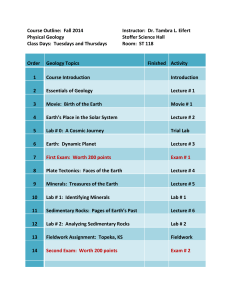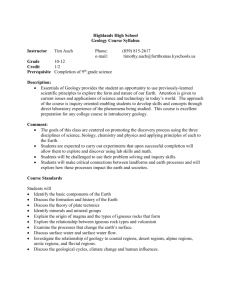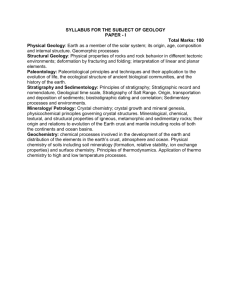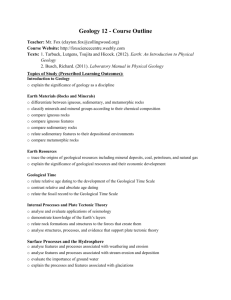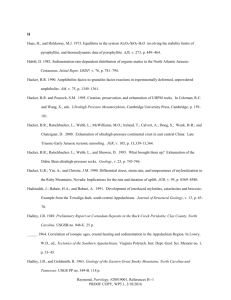Geological Sciences - College of Physical and Mathematical
advertisement
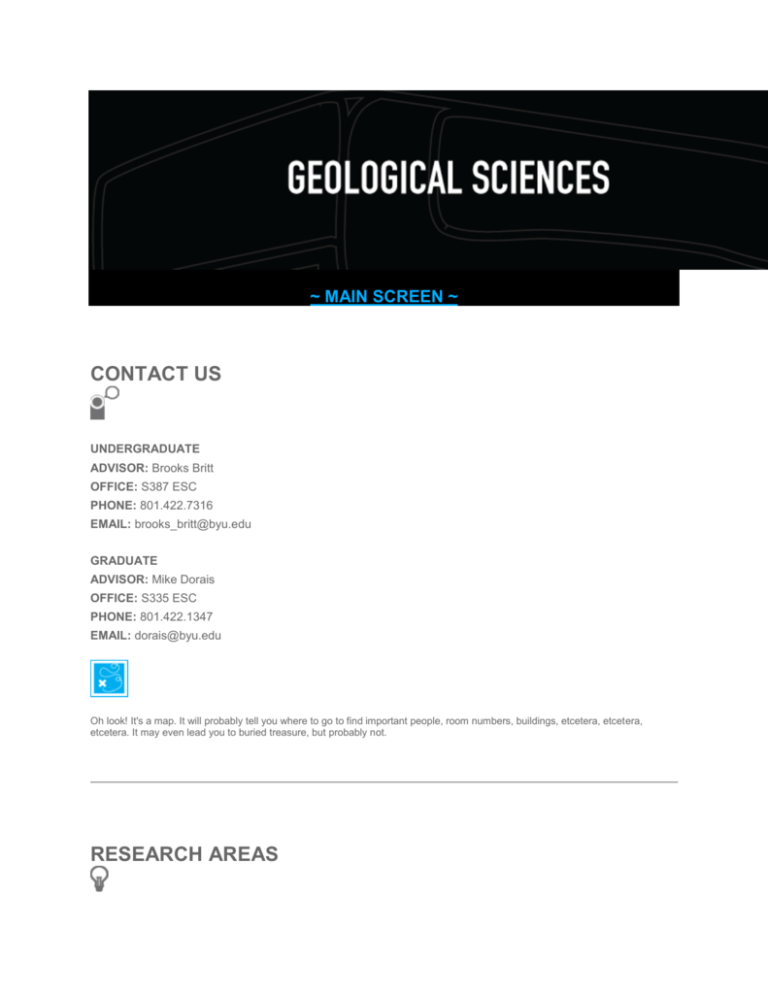
~ MAIN SCREEN ~ CONTACT US UNDERGRADUATE ADVISOR: Brooks Britt OFFICE: S387 ESC PHONE: 801.422.7316 EMAIL: brooks_britt@byu.edu GRADUATE ADVISOR: Mike Dorais OFFICE: S335 ESC PHONE: 801.422.1347 EMAIL: dorais@byu.edu Oh look! It's a map. It will probably tell you where to go to find important people, room numbers, buildings, etcetera, etcetera, etcetera. It may even lead you to buried treasure, but probably not. RESEARCH AREAS Both undergraduate and graduate students have the opportunity to work closely with our diverse 16-member faculty whose specialties include mineralogy and petrology, petroleum geology, hydrogeology, geochemistry, structure and tectonics, planetary geology, glaciology/climatology, and paleontology. Students are directly involved in conducting field research locally and across the globe in regions as diverse as Southeast Asia, the Himalayas, Switzerland, Turkey, and New Zealand. CLIMATE CHANGE GEOPHYSICS IGNEOUS PETROLOGY PALEONTOLOGY PLANETARY GEOLOGY SEDIMENTARY GEOLOGY CAREER OPPORTUNITIES Graduates have the opportunity to work outdoors and in the laboratory, pursuing careers in energy, mineral, and water resources, or in environmental evaluation with industry, government, or consulting firms. The substantial preparation in basic sciences and mathematics obtained through the program also leads to a broad spectrum of teaching opportunities. Some scholarship money is available for those who pursue a Geological Sciences degree as a pre-law track. The most marketable terminal degree in Geological Sciences is the MS. Starting salaries for this degree are often very competitive with those of other disciplines. Numerous graduates proceed to some of the best PhD programs in the country. Additionally, students are consistently placed with prominent organizations such as Exxon-Mobile, Chevron, Anadarko, as well as other viable companies in the environmental and mining industries. GEOLOGIST // $52,100 HYDROLOGIST // $69,100GEOPHYSICIST // $114,000 PETROLOGIST // $67,500 PETROLEUM GEOLOGIST // $112,900 SEISMOLOGIST // $72,400 ENGINEERING GEOLOGIST // $61,800 PLANETARY GEOLOGIST // $58,000 GEOPHYSICS X-ray vision? Not quite, but students in geophysics have their own methods for seeing down into the Earth. Using seismic imaging and 3-D visualization, geophysicists are getting an insider's look at the Earth's interior. Being able to visualize the hidden portions of the Earth furthers the science of planetary formation and evolution, archaeological digs, the search for oil and groundwater, and earthquake research. At BYU, the geophysics and visualization labs house valuable resources for these projects, including ground penetrating radar and computer stations for interactive 3-0 work Students team to integrate geology with physics and study these cutting-edge techniques as they get involved in actual research projects. ASSOCIATED FACULTY Bill Keaoh John McBride Jani Radebaugh IGNEOUS PETROLOGY Enduring intense pressure, swirling around in molten lava, and being spit up from deep within the Earth's crust: these igneous rocks have been through a lot. As a research student in igneous petrology, you'll be asking why and how these volcanic rocks have come to their final resting place. Because the formation of igneous rocks below the crust can't be directly observed, students must identify and classify these rocks, employing methods such as chemical analysis. Using the college's mass spectrometers, substantial research is done into how these rocks evolve through the process of mixing and cooling. Students work alongside top geology professors exploring volcanic regions of the world, including places like Italy and Hawaii. ASSOCIATED FACULTY Eric Christensen Mike Dorais Jeffrey Keith PALEONTOLOGY When it comes to dinosaurs, we've got them by the truck load. From gentle lumbering giants to fleetfooted predators, geology students get their hands on bones of every kind. Through the department’s mentoring program, students are involved at every stage of the paleontological process. They excavate fossils throughout the state, using dynamite, jack hammers, and various hand tools. Once a fossil has been isolated and lifted from the surrounding rock, it gets transported back to BYU‘s Museum of Paleontology. There in the “Costco of dinosaur bones,” students prepare and study fossils of all sizes, adding to the Museum's collection of over 18.000 specimens. This is a great spot for students, young and old, to see these colossal creatures recreated. The faculty behind the program and the museum are dedicated and passionate about paleontology, keeping the dynamic program on the leading edge of research. ASSOCIATED FACULTY Brooks Britt Scott Ritter PLANETARY GEOLOGY Planetary geology is out of this world, really. Geologists in this area must combine their knowledge of geology with a broad understanding of the solar system as a whole. By studying the processes that form mountains, dunes, rivers, lakes, and volcanoes on other planets, researchers can greatly enhance what is known about these formations on earth. Students and faculty at BYU are delving into what the moons of Saturn, Jupiter, and Earth can teach us about our home. Even the methane rivers and rainfall on Titan, Saturn's moon, give scientists new insights into the bodies of water we're used to. Though field trips to these moons aren't yet possible, students and faculty do visit exotic locations, like Australia, which have similar conditions to the celestial spheres. ASSOCIATED FACULTY Eric Christiansen Jani Radebaugh SEDIMENTARY GEOLOGY The key to understanding our changing world is right under our feet Since Earth's surface is composed primarily of sedimentary rocks, students in sedimentary geology have an entire world open for exploration. This science directly benefits society by finding important natural resources, including clean water, fossil fuels and several industrial products. Students conduct research that can answer pressing questions about climate change and help to mitigate natural and man-made disasters. In addition to meaningful subject matter, our students get to study sedimentary geology in one of the greatest places in the world. The Colorado Plateau of Utah, with its five national parks, is completely composed of sedimentary rocks, giving students unparalleled access to some of the greatest rock exposures and successions in the world. Because of their keen understanding and broad exposure to these environments, many of our students obtain rewarding jobs in the energy sector. ASSOCIATED FACULTY Torn Moms Scott Ritter CLIMATE CHANGE When it comes to climate change, our students are heating up the discussion Paleoclimatology research examines the changes in global climate, taking into account the interactions of the atmosphere, ocean, and land components of the earth's climate system. Within larger efforts to characterize climate, our research group specializes in studying glaciers, which act as natural recorders and indicators of changes in climate. Much of this research work requires in-field extraction of high alpine ice core samples. Students travel along with faculty members to study glaciers in Switzer1and.Antarctica, and the Himalayas. ASSOCIATED FACULTY Summer Rupper


